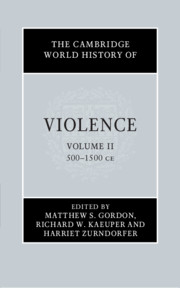Book contents
- The Cambridge World History of Violence
- The Cambridge History of Violence
- The Cambridge World History of Violence
- Copyright page
- Contents
- Figures and Table
- Contributors to Volume II
- Introduction to Volume II
- Part I Beyond Warfare: Armies, Tribes and Lords
- Part II The Violence of Governments and Rulers
- Part III Social, Interpersonal and Collective Violence
- Part IV Religious, Sacred and Ritualised Violence
- 17 Religion and Violence in China
- 18 Buddhism and Violence in Premodern Japan
- 19 Human Sacrifice and Ritualised Violence in the Americas before the European Conquest
- 20 ‘Not Cruelty but Piety’
- 21 Chivalric Violence
- 22 Jihad in Islamic Thought
- 23 Christian Violence against Heretics, Jews and Muslims
- 24 ‘Fighting for Peace’
- Part V Depictions of Violence
- Index
- References
19 - Human Sacrifice and Ritualised Violence in the Americas before the European Conquest
from Part IV - Religious, Sacred and Ritualised Violence
Published online by Cambridge University Press: 13 March 2020
- The Cambridge World History of Violence
- The Cambridge History of Violence
- The Cambridge World History of Violence
- Copyright page
- Contents
- Figures and Table
- Contributors to Volume II
- Introduction to Volume II
- Part I Beyond Warfare: Armies, Tribes and Lords
- Part II The Violence of Governments and Rulers
- Part III Social, Interpersonal and Collective Violence
- Part IV Religious, Sacred and Ritualised Violence
- 17 Religion and Violence in China
- 18 Buddhism and Violence in Premodern Japan
- 19 Human Sacrifice and Ritualised Violence in the Americas before the European Conquest
- 20 ‘Not Cruelty but Piety’
- 21 Chivalric Violence
- 22 Jihad in Islamic Thought
- 23 Christian Violence against Heretics, Jews and Muslims
- 24 ‘Fighting for Peace’
- Part V Depictions of Violence
- Index
- References
Summary
Human sacrifice and other forms of ritual violence were widespread in the pre-Columbian Americas. This chapter focuses on ritual violence and human sacrifice in the ranked and stratified societies in the south-western and south-eastern culture areas of North America, in Mesoamerica, and the central Andes. It argues that, at least in some cultures, human sacrifices represented regular donations of energy to the supernatural sphere, a kind of “food for the gods” to maintain the cosmos. This kind of energizing was extended to deified humans. Companions and retainers were sacrificed as attendants of deceased high-ranking personages. Thus, the afterlife mirrored the social hierarchy on earth. Humans were also offered for the dedication and sanctification of temples. Some sacrificial victims became impersonators or representations of deities and other supernatural powers in ritual re-enactments of particular myths. They were considered messengers or mediators in the communication with the spiritual sphere. Humans were sacrificed as special donations pleading or reciprocating for certain benefits, such as a good harvest. The sacrifice could be an act of expiation, penitence and relinquishment redressing faults or sins of the sacrificing individual or collective.
Keywords
- Type
- Chapter
- Information
- The Cambridge World History of Violence , pp. 390 - 410Publisher: Cambridge University PressPrint publication year: 2020
References
Bibliographical Essay
- 2
- Cited by

